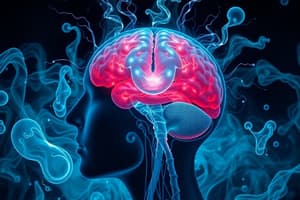Podcast
Questions and Answers
What is the primary goal during the acute phase of TBI management?
What is the primary goal during the acute phase of TBI management?
- Maintaining skin integrity
- Maximal functional recovery
- Life preservation (correct)
- Acquiring motor skills or relearning
Which assessment tool is used to evaluate the level of consciousness in TBI patients?
Which assessment tool is used to evaluate the level of consciousness in TBI patients?
- MMSE
- LOCF
- GCS (correct)
- Rancho Los Amigos
Which of the following is NOT a sign of increased intracranial pressure?
Which of the following is NOT a sign of increased intracranial pressure?
- Inappropriate behaviors
- Aggression
- Depressed mood (correct)
- Poor judgment
What type of behavior changes should be examined in TBI patients?
What type of behavior changes should be examined in TBI patients?
What is a key focus during the chronic phase of TBI management?
What is a key focus during the chronic phase of TBI management?
Which of the following is an approach to maintain skin integrity during TBI management?
Which of the following is an approach to maintain skin integrity during TBI management?
In the assessment of motor functions for TBI patients, which of the following indicates a common issue?
In the assessment of motor functions for TBI patients, which of the following indicates a common issue?
Which treatment method is important for managing contracture development in TBI patients?
Which treatment method is important for managing contracture development in TBI patients?
Which sensory stimulation technique involves using the patient's favorite smells?
Which sensory stimulation technique involves using the patient's favorite smells?
In the management of TBI, the latency of a response refers to what?
In the management of TBI, the latency of a response refers to what?
What is a primary focus when managing a patient in the Rancho Los Amigos IV-VI stages?
What is a primary focus when managing a patient in the Rancho Los Amigos IV-VI stages?
Which of the following is NOT a recommended practice when administering sensory stimulation?
Which of the following is NOT a recommended practice when administering sensory stimulation?
How should responses be evaluated in sensory stimulation therapy?
How should responses be evaluated in sensory stimulation therapy?
What type of instruction is emphasized for patients in the Rancho Los Amigos stages IV-VI?
What type of instruction is emphasized for patients in the Rancho Los Amigos stages IV-VI?
What might indicate that a patient is in the Rancho Los Amigos VII and VIII stages?
What might indicate that a patient is in the Rancho Los Amigos VII and VIII stages?
Which activity is important for engaging a confused agitated patient during rehabilitation?
Which activity is important for engaging a confused agitated patient during rehabilitation?
Flashcards
Sensory Stimulation
Sensory Stimulation
Using various sensory inputs like sounds, sights, smells, tastes, and textures to increase alertness and responsiveness in patients.
Latency in Sensory Stimulation
Latency in Sensory Stimulation
The time gap between applying a stimulus and receiving a response from the patient.
Stimulus Response Consistency
Stimulus Response Consistency
The consistency of a patient's response to a stimulus, measured by the number of successful reactions compared to applications.
Response Intensity in Sensory Stimulation
Response Intensity in Sensory Stimulation
Signup and view all the flashcards
Confused-Agitated Stage (Rancho Los Amigos Level IV)
Confused-Agitated Stage (Rancho Los Amigos Level IV)
Signup and view all the flashcards
Confused-Appropriate Stage (Rancho Los Amigos Level V)
Confused-Appropriate Stage (Rancho Los Amigos Level V)
Signup and view all the flashcards
Automatic-Appropriate Stage (Rancho Los Amigos Level VII)
Automatic-Appropriate Stage (Rancho Los Amigos Level VII)
Signup and view all the flashcards
Purposeful-Appropriate Stage (Rancho Los Amigos Level VIII)
Purposeful-Appropriate Stage (Rancho Los Amigos Level VIII)
Signup and view all the flashcards
Glasgow Coma Scale (GCS)
Glasgow Coma Scale (GCS)
Signup and view all the flashcards
Behavioral Changes in TBI
Behavioral Changes in TBI
Signup and view all the flashcards
Apraxia
Apraxia
Signup and view all the flashcards
Rancho Los Amigos Scale (Stages I-III)
Rancho Los Amigos Scale (Stages I-III)
Signup and view all the flashcards
Maintaining ROM in TBI
Maintaining ROM in TBI
Signup and view all the flashcards
Maintaining Skin Integrity in TBI
Maintaining Skin Integrity in TBI
Signup and view all the flashcards
Maintaining Respiratory Status in TBI
Maintaining Respiratory Status in TBI
Signup and view all the flashcards
Upright Position for Improved Body Alignment
Upright Position for Improved Body Alignment
Signup and view all the flashcards
Study Notes
TBI Assessment
- Assess for generalized signs of increased intracranial pressure.
- Evaluate level of consciousness and cognitive function using the GCS.
- Examine cognitive function (LOCF) by assessing learning, attention, memory, and complex information processing.
TBI Assessment (Behavioral Changes)
- Observe for inappropriate physical, verbal, or sexual behaviors.
- Evaluate judgment.
- Assess irritability and low frustration tolerance.
- Examine aggression.
- Identify impulsivity and safety issues.
- Note depressed mood and anxiety.
TBI Assessment (Cranial Nerve and Motor Function)
- Evaluate cranial nerve function.
- Assess motor function, including the presence of paresis, hypertonia, and hyperreflexia.
- Examine apraxia.
- Check balance deficits.
- Assess ataxia and coordination (cerebellar damage is common).
- Evaluate functional mobility skills (FMS).
- Determine the level of general deconditioning.
TBI Management (Overall Objective)
- The overall objective is to maximize functional recovery and support patients with residual disabilities.
TBI Management (Acute Phase)
- Prioritize life preservation.
- Ensure a functioning respiratory system.
- Maintain good circulation (monitor BP and ICP).
- Prevent secondary brain damage (including pharmacological intervention and hypothermia).
- Prevent potential complications (pressure sores, contractures, DVT, respiratory problems, postural hypotension).
TBI Management (Chronic Phase)
- The PT program is structured around the cognitive level.
- Prevent secondary complications at Rancho Los Amigos I-III levels (no response to inconsistent response).
- Maintain range of motion (ROM) and prevent contractures using passive movement, positioning, splinting, and serial casting
- Maintain skin integrity by frequently changing patient positions.
- Maintain respiratory status, avoiding complications through postural drainage, percussion, vibration, and suctioning to maintain a clear airway.
- Maintain upright positions for improved body alignment.
TBI Management (Rancho Los Amigos I-III)
- Goal: Enhance the interaction of the patient with their environment. Use sensory stimulation (stimulate all sensory modalities for arousal).
-Auditory: use speech and intermittent radio/TV.
- Visual: use people and pictures to stimulate all visual fields.
- Olfactory: use favorite smells.
- Gustatory: cautiously use flavored cotton swabs to lips and gums, avoiding aspiration.
- Tactile: use different textures.
- Vestibular stimulus: implement head movements (angular or rotational).
TBI Management (Sensory Stimulation)
- Administer sensory stimulation in short, orderly periods.
- Assess response after each stimulus.
- Evaluate latency and consistency of response.
- Monitor response intensity.
- Observe for changes in vital signs due to potential autonomic nervous system impairment.
TBI Management (Rancho Los Amigos IV-VI)
- Encourage patient mobility by getting them out of bed.
- Focus acute phase exercises on ROM, transfers, and mat exercises (rolling, lying, to sitting to standing).
- Consider gait training or wheelchair training.
- Increase endurance.
- Address specific problems
- Provide daily structure & consistency.
- Avoid overstimulation.
- Employ memory logs and relaxation techniques.
- Provide short instructions and clear feedback.
- Offer task-specific training focusing on routine, liked tasks broken down into components.
- Provide external cues (verbal or physical).
- Control instruction pace.
- Regularly re-orient patient to time, place, name, and task.
TBI Management (Rancho Los Amigos VII-VIII)
- Patient is in control and typically discharged at this stage.
- Residual memory and judgment impairment is still possible.
- Develop specific programs for continuing needs and residual problems.
- Transition back into the real world with consistent feedback.
- Implement activities of daily living (ADL) training in a practical environment.
- Encourage active lifestyle with realistic fitness routines.
- Improve posture, balance, and symmetry.
- Monitor for potential robot syndrome (robot-like movement, excessive eating, and sedentary behaviors).
Studying That Suits You
Use AI to generate personalized quizzes and flashcards to suit your learning preferences.
Related Documents
Description
This quiz covers the assessment techniques and management strategies for Traumatic Brain Injury (TBI). It includes evaluations of consciousness, cognitive functions, behavioral changes, cranial nerve, and motor functions. Perfect for healthcare professionals seeking to enhance their knowledge on TBI protocols.




